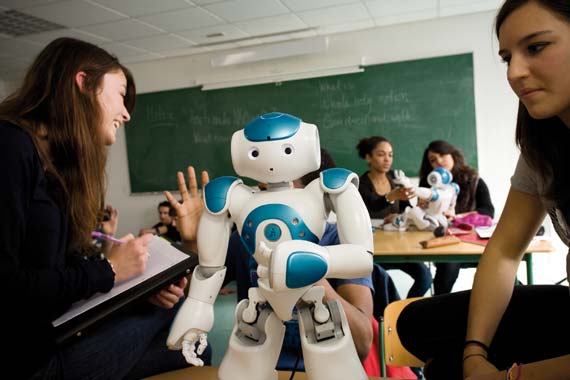STEM Education | Interview
Humanoid Robots: STEM Vehicles Today, Classroom Assistants Tomorrow
- By John K. Waters
- 10/24/11
If humanoid robots are ever to succeed as classroom assistants, they have to be stable, agile, and programmable--but above all, said Bruno Maisonnier, they have to be cute.
"In my opinion, the robot of the future will have as its main function to interact with people," Maisonnier said. "If you want people to be comfortable interacting with a robot, it has to have a humanoid shape, not a dog or a spider or anything like that. Really, they have to look cute before everything else."
Maisonnier is the CEO and founder of Aldebaran Robotics, a French company developing and marketing humanoid robots. He was in San Francisco recently for the International Conference on Intelligent Robots and Systems (IROS), a week-long conference jointly sponsored by the IEEE and the Robotic Society of Japan. Aldebaran's flagship product is a 60 cm-tall robot called NAO (pronounced "now"), which Maisonnier and his colleagues demonstrated at the conference.
"I hate this name, 'humanoid robot,'" he said. "'Humanoid' is not a good one, but 'robot' is worse. When people hear it, they think of industry. But that is not at all what we are doing. In industry robotics, you have machines that do repetitive tasks very fast, and you are prohibited to interact with the robot. For us, the interaction is the most important. It's a totally different world."
NAO was among the better known robots at the conference. The device grabbed headlines when it replaced Sony's famous robot dog, Aibo, in the Robot Soccer World Cup, better known as the RoboCup, in 2007. NAO is also the first programmable humanoid robot to be used as a standard research platform and an educational tool for science, technology, engineering, and mathematics (STEM) students.
Experiments with robot teaching assistants are underway in a few classrooms, the best known of which is probably South Korea's test of a locally produced robotic device in primary school English classes. But the greatest impact of technologies like NAO on K-12 education in the near term is likely to come from its role as a platform for STEM education. The NAO comes with a visual programming tool designed to allow students to code behaviors for the robot, including gestures, movements, sounds, music, and speech.
But Maisonnier argued that, although a robot like NAO can be used to teach students the fundamentals of robotics, it can also serve as a means of allowing students to connect theory with practice in subjects such as computer science, engineering, and mathematics.
Aldebaran developed NAO first as a piece of hardware with a core software infrastructure and then threw it open to third-party developers to add to and refine the software. The NAO hardware platform combines a range of input devices and sensors, including cameras, microphones, ultrasonic rangers, inertial measurement units, pressure sensors on its feet, as well as actuators in its joints. And it can reproduce sound and synthesize speech. The little robot can speak and understand verbal communications, see and recognize, and avoid obstacles and pick itself up when it falls. It also connects to the Internet via WiFi.

The Aldebaran NAO robot in a high school classroom |
Maisonnier said he's convinced that the role of humanoid robots in K-12 is going to change within the next decade from objects of study to true classroom assistants. And, he said, he expects them to find acceptance in that role first in narrow applications. Autistic students, for example, are likely to be among the first beneficiaries of robotic tutors, he explained.
"These children have no filters to the input all around them, and that is very painful, so they have to shut themselves off," he said. "The robot can be programmed to have little impact, to have the same, level voice and no complicated facial expressions. And robots are very good at rituals--always the same thing in the same order at the same time every morning, which gives comfort to this child. And because the robot is an object with which both the teacher and the student can interact, it can become a link between you."
Some research into this area is reportedly underway now in Abu Dhabi-based Masdar Institute of Science and Technology. The institute recently purchased five NAOs for this purpose.
He also pointed to the South Korean experiment. "They discovered something fascinating in South Korea," he said. "Because the robot is not reacting to the students, they feel less self-conscious about their bad pronunciations. They can repeat and repeat hundreds of times, and the robot will remain flat and without emotion, totally neutral."
Maisonnier was also quick to emphasize that he never expects robots to replace teachers.
"This is a tool in the hands of the educator," he said. "It's a very sophisticated tool, yes, but a tool only, one that will help them to do their job better."
About the Author
John K. Waters is a freelance journalist and author based in Mountain View, CA.